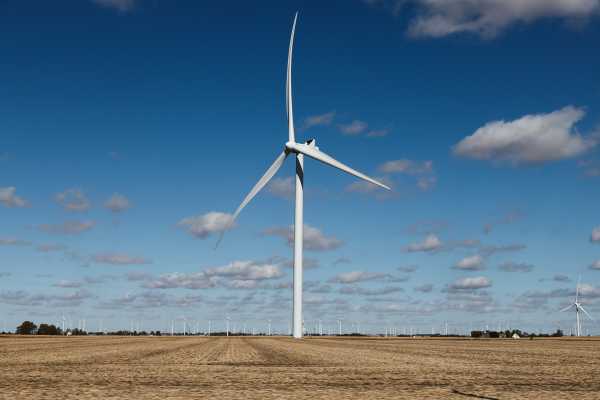 Congress so far />
Congress so far />
The current Democratic trifecta is coming to a close, and Republicans will be taking back power in the House this January. The lame-duck Congress looks to be productive, but one item that has been dropped from its to-do list may come back to haunt Democrats.
Permitting reform — a push by Sen. Joe Manchin (D-WV) to change the way big infrastructure projects that involve federal dollars are approved — was a notably divisive proposal that supporters had hoped would pass in the lame duck. But after progressives who opposed the bill, along with top Republicans, united to torpedo it, Democrats decided to pull the proposal out of a must-pass defense bill, essentially killing it. It was a personal loss for Manchin but a potentially bigger one for a key Democratic priority: building out a clean energy infrastructure, and fast.
Federal permitting reform’s defeat takes place in the shadow of the passage of the Inflation Reduction Act (IRA), perhaps this Congress’s signature achievement. Passed in August, the IRA is the largest clean energy investment in American history. On paper, the bill will help cut American emissions by 40 percent from 2005 levels by the end of the decade, through a suite of tax provisions such as credits for people getting solar panels, incentives for electric vehicles, and federal loans to help construct clean energy sources.
But as it stands, the IRA will be hard-pressed to accomplish its stated goals — and that’s thanks primarily to a 50-year-old law called the National Environmental Policy Act (NEPA), the “Magna Carta’’ of federal environmental laws.
Signed into law on New Year’s Day 1970, NEPA mandates that all federal agencies consider environmental factors in their decision-making and involve the communities where projects are taking place. The act covers not only public infrastructure projects but any project that requires a permit from the federal government or receives federal funding.
But while NEPA has served a valuable purpose over the decades, it is in tension with the objective of building out a clean-energy infrastructure. Now, in the face of the climate crisis, a broad coalition across the political spectrum is questioning whether it is time to reform the law.
Manchin’s proposal would speed up infrastructure projects by streamlining NEPA by capping the page length of environmental review reports and setting a maximum time of two years for review. If the federal government takes too long to approve a project, project applicants could take the federal government to court to make them hurry up. The bill would expedite approvals for electrical transmission, ensuring that clean energy can get from where it is produced to where it is needed. Controversially, the bill would also approve the near-complete Mountain Valley Pipeline, a natural gas system from his state of West Virginia.
But many thought that even with this controversial trade-off, Manchin’s bill was worthwhile. Permitting reform received support from both congressional leadership and President Biden, but it faced opposition from progressives and Republicans. “We’ve got to take a stand now and have the courage to say no to the fossil fuel industry,” Sen. Bernie Sanders (I-VT) announced as part of his opposition to the proposal, echoing the sentiments of 72 progressive House Democrats who wrote a letter to House leadership voicing similar concerns. In their view, a looser review process would open the door to more fossil fuel projects.
Those critics won. And while the passage of the IRA remains a real victory, whether and how that legislative win becomes a reality on the ground has become much more complicated as a result.
The history of environmental review, briefly explained
Before NEPA, the federal government hardly considered environmental concerns when undertaking projects. The interstate system was built in the 1950s, tearing through urban areas with little regard to historical communities, and ultimately surrendered cities to cars. Oil refineries emitting carcinogens were constructed next to residential neighborhoods. Thousands of disruptive dams were erected across the country with little thought, and many of them now serve no purpose as flood control or electricity generation.
Congress believed that robust federal standards for pollution and enshrining community involvement in federally funded projects could fix these and other problems. So, NEPA, along with other environmental laws like the Clean Air Act and Clean Water Act, was passed.
The flurry of legislation worked. All major categories of air pollution have fallen since 1970. US waterways became cleaner. NEPA empowered local residents to oppose freeway projects intersecting their urban neighborhoods.
But as NEPA and other environmental laws succeeded, a new problem entered public consciousness: climate change. In 1988, a watershed Senate hearing on global warming catapulted the issue to the top of the environmental priority list. Quickly, a political consensus formed on the need for the U.S. to transition away from fossil fuels and to build clean energy, such as wind, solar, nuclear, and hydroelectric, quickly and cheaply.
That consensus then ran smack into this era’s polarized politics. Decades since it first identified climate change as a problem, the US finally passed comprehensive legislation that could actually do something about the problem at a large enough scale.
But that is only if NEPA allows it.
How NEPA became an obstacle to clean energy
When the Cape Wind project wanted to build the first offshore wind farm in America off the coast of Cape Cod, opponents ranging from liberal stalwart Sen. Edward Kennedy (MA) to a Koch brother joined forces to stop it. Successive lawsuits challenged nearly every aspect of the project. Cape Wind won virtually every case, but after 16 years and $100 million, the project collapsed after additional lawsuits caused it to miss a construction deadline. The critics’ strategy was simple: “delay, delay, delay.” And it worked.
Cape Wind’s case is not unique. The Wall Street Journal reports that, on average, it “can take four to six years” for wind power projects to make their way through the permitting process. Congestion pricing in Manhattan, a plan that would incentivize cleaner transportation and discourage driving in NYC, has been put on pause while an environmental review is conducted. “I can’t fix that NEPA became a tool for attacking pro-environmental initiatives,” Metropolitan Transportation Authority chief Janno Lieber told Ezra Klein. In the 1990s, nearly 100,000 acres of the Six Rivers National Forest in California burned down while a plan to stop the wildfires went through the review process.
This story plays out time and time again with green projects. While some may be automatically exempt from environmental review, or just require an environmental assessment that takes only several months to complete, any project deemed to have a “significant” impact on the environment will trigger an “environmental impact statement” — a process that is much more onerous and lengthy than an environmental assessment.
On average, an environmental impact statement takes 4.5 years to produce and clocks in at more than 600 pages. At the conclusion of the process, projects are given a set of mitigation measures they are compelled to abide by, which can drastically warp a project from its original design and dramatically drive up costs.
Looming over this entire process are also the courts. If someone — particularly an interest group — doesn’t believe the federal government is thinking carefully about the environmental impact of an aspect of its project, or simply doesn’t want that project in its backyard, they can sue to force the government to reconsider it as part of the environmental review. This can delay the already lengthy environmental review process even further.
NEPA also emphasizes community involvement. This sounds great in concept, but in practice, it can be horribly undemocratic. The nature of community involvement narrows down who is able to participate to those with a lot of free time, like retirees and wealthy homeowners, leading to unrepresentative groups claiming to speak for the rest of the community to block progressive projects. As Jerusalem Demsas writes in the Atlantic, the community-input system “is fundamentally flawed: It’s biased toward the status quo and privileges a small group of residents who for reasons that range from the sympathetic to the selfish don’t want to allow projects that are broadly useful.”
The effects of this ostensibly environmental process on green projects can be stark. Currently, the US has just 42 megawatts of operational offshore wind power. A whopping 18,581 megawatts of offshore wind power is tied up in environmental review. A new expansion of Seattle’s light rail network was approved by voters in 2016, but not a single track has been laid. Environmental review for the project has been ongoing since 2019 and is not expected to be done until 2023. The draft environmental impact statement itself is 8,000 pages long.
To be sure, many aspects of environmental review exist for a very good reason. The urban freeways cutting through our cities is testament to the societal cost when we don’t think through potentially significant infrastructure projects. So too does it make sense that the public has the right to tell the government that they might be wrong. Abolishing NEPA altogether would be a mistake.
The issue, rather, is that through NEPA’s lens, all projects are viewed as potentially having a negative impact on the environment. But clean energy projects have a positive impact because they cut greenhouse gas emissions. And the process that NEPA created has no way of recognizing or factoring in such environmental gains.
Sen. Manchin’s proposal wouldn’t have resolved all the kinks of the permitting process, but it would have smoothed many of them out. Under Manchin’s bill, the “delay, delay, delay” strategy would no longer be effective. Litigation and community input would still be permitted, but couldn’t stretch out a project timeline indefinitely — all still while preserving the original intent of NEPA and other environmental protections.
Now what?
Following permitting reform’s exclusion from the National Defense Authorization Act, Manchin did release a newly revised version, but its outlook in the lame-duck Congress appears dim. House Republicans may revisit the issue next Congress, though it will be on their own terms, and they will likely pursue far more aggressive changes to the federal permitting process than what Manchin sought.
Changes could happen elsewhere. The IRA did include provisions to help expedite federal permitting. Some $350 million was allocated for the Federal Permitting Improvement Steering Council, whose job it is to make the federal permitting process more efficient.
Sixteen states also have so-called “Little NEPAs” on the books that have similarly drawn controversy. These state laws have been used in the past to block UC Berkeley from expanding enrollment and roll back Minneapolis’s plan to upzone residential parts of the city. “Little NEPA” reform would go a long way, piece by piece, to accomplishing at the state level what couldn’t be done at the federal level.
But the failure of federal permitting reform underscores a real reluctance to match talk with action. Republicans have long called for permitting reform, only to oppose it when the opportunity for political payback beckoned. Progressives in Congress have long been the loudest voices for fighting climate change. But the intensity of their rhetoric isn’t coupled with policy moves that could put the US on a faster track to a clean energy future.
Commentators have taken notice of how America has lost its ability to build. Climate change demands that we solve this problem. The only way out is up, by building a lot of wind turbines, a lot of nuclear power plants, a lot of electrical transmission lines, and more. But currently, we can’t do any of that cheaply or quickly. Permitting reform may sound like a wonky technocratic fix, but it is actually a large piece of the puzzle to fixing these problems. The end of the fossil fuel economy is on the horizon. How quickly we get there is a policy choice.
Colin Mortimer is the director of the Center for New Liberalism at the Progressive Policy Institute. He can be reached via email at [email protected] and on Twitter at @colinmort.
Sourse: vox.com






